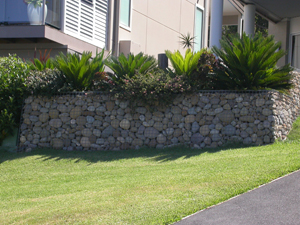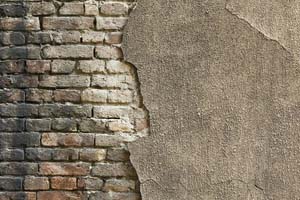
Gabion wall
Up until about 20 years ago Australians played it safe when choosing their style of garden wall. But over the past ten years Australian manufacturers and home owners have ventured out and there are now some great new products on the market.
Here are six steps to help you choose the best wall for your property.
Step 1: Create a performance specification
A performance specification sounds complicated, but it is very simple. Make a list of all the criteria your fence needs to fulfill. You will be surprised how many types of wall you eliminate when you compare your list to a list of features for a particular wall type.
EXAMPLE:
The wall needs to:
- Contain unsupervised children and be un-climbable
- Offer privacy from the neighbours to the north
- Be a large and flat so the kids can use it as a chalk board
- Be solid so that heat will radiate from the wall in the cooler parts of the day, offering a longer growing season for summer herbs
- Protect the yard from the wind
- Offer security to the yard and home, with appropriate lighting
- Block-out traffic noise
- Be inexpensive
Remember - your fence should meet all your needs, not just your aesthetic requirements.
Step 2: Choose appropriate materials
Most people probably feel this is the most important thing to consider when choosing a fence. The wall materials chosen should not only complement your garden theme but should also suite the style of your house. Do a little Googling to see what materials looks good together, not just what looks good on its own.
The safe and traditional styles in wall fencing can often be the best solution for your job, and are worth considering against the newer options. But remember, no matter what type of heavy weight wall you choose, anything over 600mm high will most likely require concrete strip footing supports, so check with your local council or ask a landscaper. Below are a few materials to consider.

Old rendering over brick
Double-face brick construction
This type of fence lasts and it does not need to look boring. Adding detail, although a little more costly, will give you a classic look. However construction of a detailed brick wall requires the services of a professional bricklayer with detailing experience.
Cement render
Cement rendering old brick garden walls can bring life into a neglected garden. To get a perfectly finished wall, hiring a professional renderer is required, but if you are happy to go for the bagged look, give it a go yourself.
Concrete block walls are the easiest to apply render to, especially in comparison to clay bricks. Brick walls require more preparation than concrete walls because clay bricks are constantly expanding and contracting and the render is constantly shrinking.
Light-weight cement render
Modular Walls (MWS) supply a look-a-like fibre cement wall system that has the same aesthetics as a tradition brick rendered wall at about half the cost. The Modular Wall system can be installed in a fraction of the time and is the perfect option if you are building around easements and are not permitted to use strip footing construction. Modular Walls use a steel pier-and-beam system with a fibre cement composite sandwich panel. This type of fence or wall can have the same substantial proportions as a regular double brick fence. To download the Modular Walls brochure click here.

Dry stone wall
Dry stone
Stone walling is classic, virtually maintenance free, and dates really well, but it tends to be expensive. The stone is actually quite inexpensive, it is hiring a stonemason that costs. If your wall is over 600mm in height an engineer will need to design the footings, and you should leave the construction to a professional. But if the wall is under 600mm, and you are up for a little DIY, you can save a lot of money.
Gabion
Gabion walling and retaining is becoming quite popular. This style of wall is versatile, strong and perfect for DIY. Gabion is a wire basket or wire form, filled with stones and shaped into a fence or retaining type structure.
It is still commonly used in civil works for soil retention, drainage and erosion control. Gabion fencing is now widely used in residential fencing and soil retention solutions and is specified by many building designers and architects for new houses and renovations.
Custom
See these links for some inspiration if you feel up to creating your own custom fence:
Living

Living wall
Living walls or living fences are just that. They are made up of plants that can be left to grow wild, or trimmed if you are going for the ordered look. Be aware though if one plant dies in your perfectly ordered fence it may be difficult melding in another to take its place. These fences are often better for people with lots of time and interest in theirgarden .
There are now companies that specialise in the supply and install of artificial garden walls. These vertical gardens are perfect for small yards and easy for the DIYer to install.
Step 3: Ensure your fence will meet your privacy needs
Visual privacy
Before you install your fence you need to know for certain that you get the privacy you require. Put up a simple timber frame structure, or a sheet, to the height you want your fence and see if it gives you the privacy you are looking for. If you have neighbours uphill from your property it will be almost impossible to use a fence for privacy.
Acoustic privacy
In general most masonry and brick walls will provide great acoustic privacy. However if a wall is smooth it may cause noise reverberation around your yard.
Tip 4: Choose a fence that meets your security needs
Solid and smooth, rendered and heavy walls are great for security, but walls that can provide a foothold are not. When choosing your fence for security ensure that your wall has no protusions more than 10mm in size. The 10mm rule is used for pool safety fencing - anything over 10mm is considered climbable. That means Gabion walls are out.
Tip 5: Think about the wall details & design-type early
The type of design you choose will play a role in making a wall last. If it has been designed correctly the owners will ensure it continues to look so, taking pride in their fence.
Tip 6: Select a wall that will meet your safety requirements
If you need to secure a pool area or a yard from a busy road read the Australian Standard for pool fencing. It is actually not that difficult to read.
Tip 7: Keep within your budget
Garden walls vary greatly in price, but assume the walls with the greater labour content will be more expensive than another. Many of the walls discussed above have a large labour component, perfect for DIY person.
Armed with the right information there is no reason why garden walls should look drab or cost the earth. Just stick to the seven tips above and you will be basking in the sunshine of your greatness every time you look at your garden wall.
